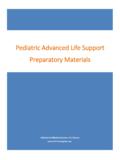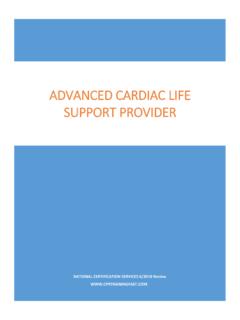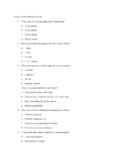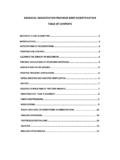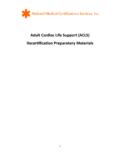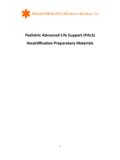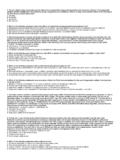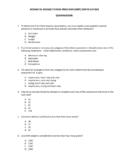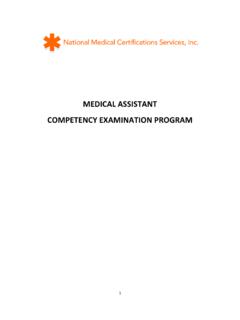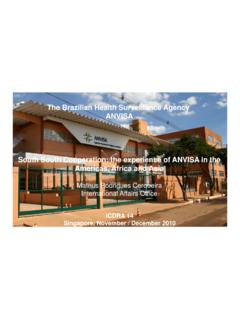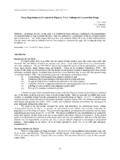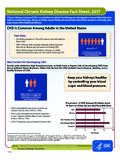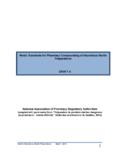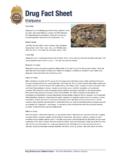Transcription of PHARMACY TECHNICIAN COMPETENCY …
1 1 PHARMACY TECHNICIAN COMPETENCY EXAMINATION PROGRAM 2 PHARMACY TECHNICIAN CERTIFICATION TABLE OF CONTENTS Dosage Calculations and Math General Substance Abuse, Vitamins, Psychotropic and Antibiotic 3 Dosage Calculations and Math Review 1. In a fraction, the number below the line is called the denominator. 2. In a fraction, the number above the line is called the numerator. 3..25 equals 25/100 4. When you add .35 mg + .45 mg + .200 mg, the answer is mg. 5. If compound A must be added to compound B so that the proportion of A to B is 3 to 1, 15 grams of compound A must be added to 5 grams of compound B. 6. Liter, milliliter and kiloliter are measurements of volume. 7. To convert a patient s body weight to kilograms, divide the number of pounds by 8.
2 Minim is the smallest amount of liquid measure. 9. The normal range of temperature for the human body is 97 to 99 degrees, or to Celcius 10. A vial is a small, sterile, pre-filled glass bottle containing a hypodermic solution or powder for reconstitution. 11. Parenteral means that medication is injected into the body. 12. An ampule usually holds 1 dose of solution. 13. Solutions, elixirs and syrups are examples of liquid preparations. 14. A physician orders 650mg of Tylenol. You have 325 mg tables on hand. You will give 2 capsules to the patient. 15. The body surface area is considered one of the most accurate methods of calculating dosages for children up to 12 years old. General Pharmacology 1. A narcotic drug produces sleep or stupor by depressing the nervous system.
3 2. A substance that may cause physical and/or psychological dependency is addictive. 3. The process of determining the strength and quality of a drug by testing it on an animal or on an isolated organ is called bioassay. 4. The study of drugs and their actions on living organisms is pharmacodynamics. 5. The study of metabolism and action of drugs within the body is pharmacokinetics. 6. Replacement drugs are used to take the place of substances normally found in the body. 7. Prophylactic drugs are used to ward off or lessen the severity of disease. 8. The formula that shows the composition of the drug is a chemical name. 9. The official name of a drug is its generic name. 10. Drug brand names must be registered by the US Patent Office. 4 11. Insulin comes from pancreas of pharmaceutical companies, in addition to cow and hog pancreas.
4 12. Sulfa drugs have widespread use in the treatment of urinary problems. 13. Schedule I drugs are not accepted for medical use in the US. 14. Schedule III drugs are not subject to federal order form requirements. 16. In a medical setting, controlled substances are kept in a locked compartment. 17. The audit sheet for controlled substances is signed by two individuals at the end of each day. 18. When a drug should not be given to a specified person, this is a contraindication. 19. When a fractional portion of a medication is administered at short intervals, the dosage is said to be divided. 20. A toxic dose could poison a patient, without being deadly. 21. Controlled substances must be double locked by Federal law. 22. Cumulative dose is the summation of a drug present in the body after repeated medication.
5 23. That in which a substance is dissolved is called solvent. 24. The solid that is dissolved in a liquid to form a solution is called a solute. 25. When a drug is injected, it must be liquid. 26. A drug may be classified as aqueous or alcohol, according to the solvent used. 27. In an elixir the bitter or salty taste of the drug is disguised. 28. Alcoholic solutions of easily vaporized drugs are called spirits. 29. Aerosols use a propellant and are packaged in pressurized units. 30. Capsules are designed as two-part containers to help them dissolve in the stomach. 31. Sublingual tablets are designed to be placed under the tongue. 32. Scored tablets are those whose surface is bisected by a groove in order for the user to break them in half. 33. Nictrol is an example of a transdermal system.
6 34. Ingesting a pill by mouth is not an example of parenteral administration of medication. 35. Intravenous pertains to within a vein. 36. Systemic medications are carried throughout the body by the bloodstream. 37. An anti-emetic prevents or relieves vomiting. 38. An anti-coagulant prevents or delays blood clotting. 39. The purpose of an expectorant is to clear the broncho-pulmonary passages. 40. A diuretic increases excretion of urine. 41. Drug interaction may occur with the use of foods, alcohol and tobacco. 42. Aspirin and acetaminophen are examples of analgesics and antipyretics. 5 43. An adverse reaction is an unfavorable or harmful unintended action of a drug. 44. The prescription is a written legal document. 45. Prescriptions may not be refilled without the physician s authorization.
7 46. Refrigerate, may cause drowsiness and discoloration or urine are typical caution on a medication label. 47. NPO indicates nothing by mouth. 48. q3h indicates every 3 hours. 49. The abbreviation for as needed is prn. 50. The abbreviation for after meals is 51. After use, disposable needles should be placed in a puncture-resistant container. 52. The gauge of a needle is measured by the size of its lumen. 53. Vial is not a component of the syringe. 54. Subcutaneous, intravenous, intramuscular and intradermal are routes for parenteral injection. 55. Before mixing two solutions in one syringe, one should check with the pharmacist. 56. A disadvantage of using the parenteral route for medication administration is that injections can injure tissue, nerves or veins.
8 57. Bones, nerves and large blood vessels should be avoided when giving injections. 58. The body areas used for an intradermal injection are deltoid muscle and/or gluteal muscle. 59. If an accidental stick occurs after an injection, you would thoroughly wash the site, applying an antiseptic and report and document the incident. 60. A correctly administered intradermal injection will produce a wheal. 61. Antibiotics are common drug therapy for allergies. Substance Abuse, Vitamins, Psychotropic and Antibiotic Agents 1. Withdrawal is the term for a set of physiological symptoms that occur when an individual is no longer taking a substance to which he or she has become addicted. 2. Alcohol is the most commonly used drug in the US. 3. Very high doses of barbiturates can cause death.
9 4. The nutrient level recommended by the National Research Council and Nutrition Board to be adequate for most healthy individuals is termed RDA. 5. Minerals are nonorganic substances that are essential constituents of all body cells. 6. Drugs that elevate a person s mood are anti-depressant agents. 7. Anti-manic agents are used to treat the manic episode of bipolar disorder. 8. Nembutal and Seconal are barbiturates. 6 9. Anti-psychotic agents are chemical substances that relieve anxiety and muscle tension. 10. Morphine is a depressant. 11. A pathogen is a microorganism or substance that is capable of producing disease. 12. Contaminated blood, vectors and human carriers are modes of transmission for pathogenic agents. 13. Meningitis is commonly treated with penicillin.
10 14. Immunization is the process of inducing or providing artificial immunity by administering an immunobiologic agent. 15. Bacille Calmette-Guetin is used in the high incidence of tuberculosis. 16. Pertussis is the medical term for the common cold. 17. Patients who should not receive live, attenuated-virus vaccines include persons with immunodeficiency disease and leukemia. 18. De-differentiation is the process whereby normal cells lose their specialization and become malignant. 19. Extravasation is the process whereby liquid escapes from veins into surrounding tissues. 20. The spreading of cancer cells from one part of the body to another is called metastasis. 21. Malignant means cancerous. 22. Signs and symptoms of breast cancer include unusual nipple secretions, dimpling of the skin and movable lumps.
